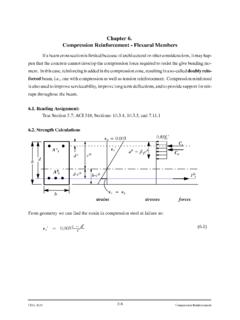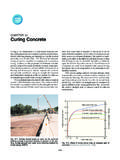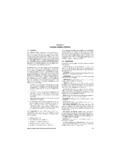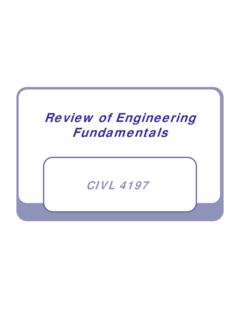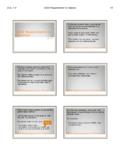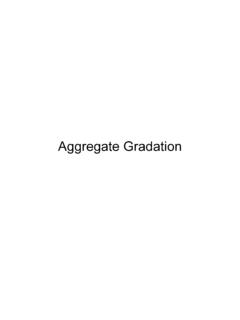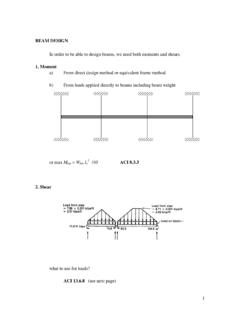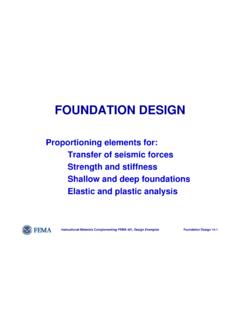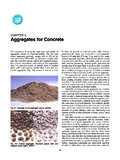Transcription of CHAPTER 13. DEFLECTION - Civil Engineering
1 235pageCIVL 4135 DeflectionCHAPTER Reading AssignmentText: Sect through and 318: Chap Calculation of DEFLECTION of R/C beamsReview of theory of DEFLECTION of homogeneous beams in elastic flexure:xyy(x)dxw(x)It is possible to make the following observations from geometryDeflection =y(x)Slope =dy/dxCurvature =d2y/dx2= =1/ y= dx dxand, with similar observations based on equilibrium forMoment;M=EId2y/dx2=EI Shear;V=EId3y/dx3=dM/dxLoad;w=EId4y/dx4= dV/dxM= wdxdxFor a homogeneous beam under constant momentat locationc: x=cd /dxc/ =cd /dxtherefored dx=1 sod MM c236pageCIVL 4135 DEFLECTION x=c and x=Ec and for equilibriumM= (Ec2 )dA=(E ) c2dAorM=EI MEI=1 = where becomes alinkbetween geometry and back to the real world, we see that the relationships developed for homogeneous members are notapplicable to concrete members.
2 New relationships must be approaches are common:1)Develop a synthetic EIfor the beam and use the relationships developed for homogeneousbeams -- ACI 318 endorsed this approach for calculation of service load )Calculate a relationship between moment and curvature which considers all levels of mo-ment. This can be used when a more accurate estimate of DEFLECTION is desired or when loadslarger than service loads are ACI Code MethodConsider only service loads and service load deflections. Cannot handle ultimate DEFLECTION is composed of two components:1)Instantaneous DEFLECTION -- when loads applied2)Additional deflections which occur over time due to creep and shrinkageConsider first the instantaneous DEFLECTION .
3 For moments at or below the cracking moment, the moment ofinertia is that of the uncracked transformed section (Iut);E=Ec. Assumefr= (f c)237pageCIVL 4135 DeflectionAt moment larger than the cracking moment, behavior is complex, not entirely loadmomentMcr=frIut/ytIutIcrIvaries incracked regionThe effective moment of inertia of the beam (Ie) depends on:a) Shape of the moment diagram -- Depends on loadingb) Crack pattern and Spacing (not predictable)c) Amount of reinforcing, location of bar cut offs, and changes in sectionThe results have shown that the following approximation gives reasonable results:ACI McrMa 3Ig+ 1 McrMa 3 Icr IgACI Eq. (9--7)WhereMcr=frIgytand fr= ACI Eq.
4 (9--8)Ma=Maximum moment in member at stage of DEFLECTION is computedIcr=Moment of inertia of cracked, transformed section (at steel yield)Ig=Moment of inertia of gross concrete section -- neglect reinforcementyt=distance from to tension faceThe effective moment of inertia is somewhere between Igand Icr; is assumed constant for entire spans, take average of maximum positive and negative moment 4135 DeflectionNote the limiting values of the equation:when Ma=Mcr,Ie=Igwhen Ma>> Mcr,Ie Icr MMcr crEcIcrEcIutNonlinear Consideration of Long--Term Deflections -- Creep and Shrinkage DEFLECTION due to shrinkage comes soon after casting (majority) with long term shrinkage depen-dent on environment.
5 DEFLECTION due to creep is proportional to stress level and concrete method for calculating long term deflections: (ACI ) total= instantaneous+ instantaneouswhere = 1+50 Eq. 9--10 of ACIWhy is is used? Primary creep effect in compression zone. Steel does not creep -- takes load from concrete concrete stress reduced -- creep decreasedbased on cornell studies, Variability and Analysis of Data for 318--71 method ACI journal, January 1972. T is a time dependent coefficient which a material property depending on shrinkage and is given in commentary Fig. page 98 of ACI Code. should be taken at midspan for simple and continuous spans and at support for cantilever. Values of T are satisfactory for beams and one way slabs but underestimates time dependent de-flection of 2--way slabs.
6 For f c> 6000 psi lower values of T should be Permissible DEFLECTION in Beams and One-Way SlabsPermissible deflections in a structural system are governed primarily by the amount that can be sus-tainedbytheinteractingcomponentsofas tructure withoutloss ofaesthetic appearanceand withoutdetrimentto the deflecting member. The level of acceptability of DEFLECTION values is a function of such factors as thetype of building, the use or nonuse of partitions, the presence of plastered ceilings, or the sensitivity of equip-ment or vehicular systems that are being supported by the floor. Since DEFLECTION limitations have to be placedat service load levels, structures designed conservatively for low concrete and steel stresses would normallyhave no DEFLECTION problems.
7 Present-day structures;however, are designed by ultimate load procedures effi-ciently utilizing high-strength concretes and steels. More slender members resulting from such designswould have to be better controlled for serviceability DEFLECTION performance, immediate and Empirical Method of Minimum Thickness Evaluation for DEFLECTION ControlThe ACI Code recommends in Table (a)minimum thickness for beams as a function of the spanlength, where no DEFLECTION computations are necessary if the member is not supporting or attached to con-struction likely to be damaged by large deflections. Other deflections would have to be calculated and (b)ifthetotalbeamthicknessislessthanrequ iredbythetable,thedesignershouldverifyth e DEFLECTION serviceability performance of the beamthrough detailed computations of the immediate andlong-term Permissible Limits of Calculated Deflectionthe ACI Code requires that the calculated DEFLECTION for a beam or one-way slab has to satisfy the ser-viceability requirement of minimum permissible DEFLECTION for the various structural conditions listed inTable (b)if Table (a) isnotused.
8 However, long-term effects cause measurable increases in deflectionwith time and result sometimes in excessive overstress in the steel and concrete. Hence, it is always advisableto calculate the total time-dependent DEFLECTION and design the beam size based on the permissible span/de-flection ratios of Table (b)240pageCIVL Second Approach to DEFLECTION Calculation (Sect. of text)Determine a relationship between moment and curvature for entire range of beam =1 = ccc cwe know c , and cfor three particular moment conditions: cracking yield nominalThe M-- curve can be constructed with these three points:MomentCurvature cr y nMnMyMcr cr y nDeflectionMnMyMcr241pageCIVL 4135 DeflectionBy being able to relate to M, curvature distribution for any loading can be plottedMcr cr cr yMcrMyMcrMyMn cr y nUse this curvature diagram as we would for an elastic homogeneous member: Moment area is a simple way to obtaindeflection using this 242pageCIVL Three rules for using moment--area method.
9 Rule 1) The change in slope between A and B ( ) is equal to the area of the diagram between A 2) The DEFLECTION of B from the tangent at A ( ) is equal to the moment of the diagram betweenA and B about 3) Two points on the elastic curve, or one point and the direction of the tangent at the point arerequired to locate a curve in Example of DEFLECTION calculation using M-- curve and Moment--Area Method:Consider a beam section for which the following M-- curve has been developed. Find DEFLECTION atpoint of loadfor cracking, yield, and ultimate cr y nMn= 5,000My= 4,000 Mcr= 2,000 cr=50 10 6 y=200 10 6 n=500 10 6first crackingfirst yieldingNominalPcr=20kips200 200 2000 -- k50x10-- 6in-- 1 cr = Moment of diagram about BABarea of diagram == (400 in)(50x10-- 6in-- 1)(1/2)= =1 10 2 200= cr= 2 =1 =(50 10 6)(200)(12)(200)(13)= , cr=1 =1 4135 DeflectionPy=40kips200 200 4000 -- k50x10-- 6in-- 1 cr AB = y= 2 =62 6in-- 12000 -- kAt Yielding15,00010,000250025002, 500(300+1003)=833, 333 10 6(15, 000+10, 000)200=5, 000, 000 10 62, 500(2003)=166, 666 10 6 =6, 000, 000 10 6 =6in =2,500(100+1003)=333, 333 10 65,000(50)=250, 000 10 67,500(1003)
10 =250, 000 10 6 =833, 333 10 6 = 4135 DeflectionPn=50kips200 200 4000 -- k50x10-- 6in-- 1 cr ABAB200x10-- 6in-- 12000 -- kAt Nominal Load5000 -- k500x10-- 6in-- 112,0006,0006,00012,00012,0002,0002,000 = (3)(12,000)+(2)(6,000)+2(2,000) 200 10 6= n= 2 = = (2, 000)(120+803)+(6, 000)(6)+(6, 000)(40+803)+(6, 000)(20)+(6,000)(403) 10 6= How to Find a Moment-Curvature for a BeamCrack Momenthbcd--c 1f1 r= 1(h cc)fr=f1(h cc)strainsstressesCcTcdforces s= 1 d cc Tsh--c =Asbdn=EsEccd=2 (n 1)+(h d)22 (n 1)+2(h d)solve for c and curvature will be = =f1 EccYield Momenthbcd--cfycd cEcCcdforcesTsfycdfyc=kd =Asbdn=EsEck= n+( n)2+2 n solve for c and curvature will be = = ycd cc=fy ECd cc=kd247pageCIVL 4135 Deflectionn=EsEcB=bnAsIg=bh312 Without Compression Steelkd=(2dB+1 1) BIcr=bk3d3 3+nAs(d kd)2 With Compression Steelkd= 2dB(1+rd d)+(1+r)2 (1+r) BIcr=bk3d3 3+nAs(d kd)2+(n 1)As (kd d )2 Gross SectionCracked Transformed SectionGross and Cracked Moment of Inertian=EsEcC=bwnAsf=hf(b bw)nAsyt=h 12 (b bw)h2f+bwh2 (b bw)hf+bwh Ig=(b bw)h3f 12+bwh3 12++bwh(yt h 2)2+(b bw)hf(h hf 2 yt)2 Without Compression Steelkd= C(2d+hff)+(1+f)2 (1+f) CIcr=(b bw)h3f 12+bwk3d3 3++(b bw)hf(kd hf 2)2+nAs(d kd)2 With Compression Steelkd= C(2d+hff+2rd )+(f+r+1)2 (f+r+1) CIcr=(b bw)h3f 12+bwk3d3 3+(b bw)hf(kd hf 2)

